Building A War Boat
Building a replica 18th century bateau that’s 35 feet long and weighs 1200 pounds is probably not the first boat-building experience most of us would think about. But 10 years ago I had the opportunity, with several others, to get in on this project.
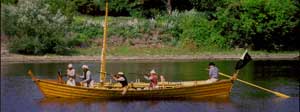 |
The Rooster, is a reproduction of an 18th/19th century bateau. It's a 34 ft, double ended, flat bottom scow with lapstrake construction.
click images to enlarge |
Since 1984, I have been an historical re-enactor, one of those curious people who dress up in old-timey clothes and uniforms, with musket in hand, to recreate a skirmish at an historic site or celebrate a “founder’s day” event. It’s great fun and I’ve made a lot of friends over the years.
In October, 1999, I had a conversation with Chris Booth, a local custom housing builder, fellow re-enactor, and supporter of the Battle of Plattsburgh Association, about building a bateau in Plattsburgh, NY. (The Battle of Plattsburgh, Sept. 11, 1814, was the last naval battle on Lake Champlain between the United States and England. Sometimes it’s referred to as the Battle of Lake Champlain. We hold a commemoration re-enactment every year).
| The Rooster in action at the Battle of Plattsburgh, Sept. 2007 - picture supplied by the Plattsburg Press Republican |
 |
We decided we needed a bateau (doesn’t everybody?) and he offered his very large and well equipped building shop to put one together. We made up a materials list and Chris solicited donations from local building suppliers. Shortly after, by January, 2000, we were joined by Travis Tucker, Craig Russell, Keith Herkalo and Jack Barrette, all experienced woodworkers and/or boatmen. We spent four hours every Monday night for the next eight months building the boat. By August 2000, it was done, just in time for the Battle of Plattsburgh.
An 18th century bateau is a work boat, a double-ended flat bottom scow propelled by oars although a simple sail was occasionally added. Bateau is the French word for boat, and these boats were commonly used in New York and New England from the French & Indian Wars onward into the 19th century. Their common waterways were Lake Champlain, Lake George, the Mohawk River, the St. Lawrence River, and the Great Lakes Ontario and Erie. They were often built on the edge of the wilderness by carpenters using wood from whatever trees were available.
 |
On the St. Lawrence River near Mallorytown, Ontario, with the gunboat Royaliste. |
They could be the original “instant boats” because a small crew of carpenters could knock one together within a week. They were rough as a corncob, were used hard, and had a short life expectancy of a few years. They had shallow draft intended for rivers and shoals. Their usual role was as a hauler of people, barrels of flour and gunpowder, lumber, furniture, small livestock, and as a fishing boat. When the military adopted them, a small swivel gun was added. Some say they take their origins from Grand Banks fishing dories. Eventually they would evolve into what Howard Chapelle described as an American sharpie.
Craig Russell, another re-enactor, was lucky to find a set of plans from the New York State Museum. These were a composite of original bateaux that had been resurrected from the bottom of Lake George, Lake Champlain and other inland waterways. The re-created prototype had been first built by a school group in southern New York. Our boat was the second off these plans.
The Rooster is 35 feet long from stem to stern along the gunwales. The waterline is 29 feet. The beam is 7 feet wide across the gunwales, 5 feet across the bottom.
The bottom is flat, no keel, made up of butt-jointed 5/4” white pine. The sides are of lapstrake construction made up of nominal 1” white pine (which is actually ¾” white pine). The ribs, bow stem and sternpost are red oak. The thole pins or oarlocks are black locust. All trim is white pine. The 12-foot oars and 14-foot steering sweep are white ash, which we planed down from green rough stock.
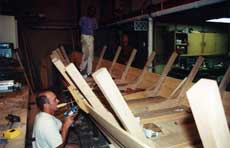 |
Planking |
Fasteners are crowned square nails from Tremont Nail Co., Mansfield, MA, clinched over. Finish is a mixture of turpentine and boiled linseed oil. Early on, we used black Sikaflex caulking which then ran about $18US a tube through local marine dealers. We found that it was peeling and stripping out after one year. Now, we use common black exterior silicone caulking, at about $2 a tube, and find that it lasts longer and adheres better. It’s shiny when seen up close, but otherwise looks like tar..
| Butt Block |
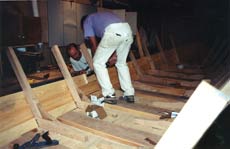 |
With a five-man crew on board (four oarsmen and coxswain) our draft is little more than 6 inches… very useful in shallow inland lakes, rivers and shorelines. It is easily beached. The Rooster is light and handy. It can turn on a dime and rides high on the water.
You may notice there’s a carved rooster head on the bow stem. That was done by Chris Booth’s father, Kit, who is a notable local bird carver. It’s not authentic for a work boat but it is a beautiful touch we couldn’t refuse.
The top of the bowstem sports a hand-carved head of a rooster, executed by Kit Booth, a noted birdcarver in the Plattsburgh area. This is not historically correct for the period, but it was a gift we couldn't refuse.
The swivel gun is mounted on a post that is anchored through the bow deck and to the floor below. |
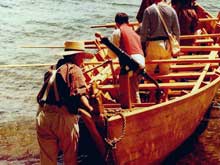
|
The square sail rig is a simple affair. The mast is a 14-foot stick of red pine we found in the local woods. The 12-foot spar is cedar. The sail is an 11x11 piece of canvas painter’s tarp with manila bolt ropes sewn in by hand. The sail is laced to the spar, and the foot is loose. The mast is easy to step, there’s a shoe on the floor and it leans into a half-circle notch cut into a seat thwart or mast partner and it’s lashed in place with rope. There’s a forward stay and two shrouds. Under sail, the spar lines and sail sheets are held by hand or wrapped around the oarlock pins.
 |
The sail is an 11x11 piece of canvas painter’s tarp with manila bolt ropes sewn in by hand. |
It runs well downwind and on a broad reach, plugging along at about 2 knots. Occasionally, we try a beam reach and that works but, since it has no keel or leeboard, I’m constantly correcting with the stern sweep.
I think we could do a lot better with a balanced lug sail and better canvas, and a leeboard, but it’s questionable if that rig would ever have been used on these boats in the 18th century.
The swivel gun is a 1-pounder, 1-1/2 inch bore. It’s about 30 inches long and weighs about 75 pounds. We bought it from a Canadian foundry that was doing a run of a dozen castings. It has a stainless steel bore sleeve. A local machine shop did the finish turning on a lathe to smooth it up and highlight the barrel rings. Of course, at re-enactments, we only shoot blank charges of about 300 grains of black powder.
| The swivel gun is a 1-pounder, 1-1/2 inch bore. It’s about 30 inches long and weighs about 75 pounds. |
 |
We also carry a 40-pound kedge or fisherman’s anchor, obtained from Washington Chain & Supply in Seattle. We carry about 100 feet of manila anchor line and chain. That may sound short and light but it works. We don’t anchor that often, usually we’re beached or tied up to a tree.
Whether or not to fiberglass the bottom of the boat was a controversial issue with us right from the start of construction. Initially, we decided to stay pure to 18th century construction and go all natural wood. In other words, no glass applications – the wood and caulking would have to hold the water, in and out.
After three years we realized the problem: We were storing the boat in a dry heated environment. Each year, we would take it out and soak it from the inside (filling it up with water) to get the boards to ‘make up’ with water, and seal the edges tight. We had no place to put it in the lake for the season and let it seal naturally over the summer.
After each weekend event, we would take it out and let it sit for another year in a dry environment. We could see that this was taking its toll on the wood: shrinking, splitting, checking.
Finally, in 2003, for the sake of maintaining the integrity of the hull, we decided to fiberglass the bottom up and around the garboard and up to the edge of the first strake. We painted it black. The glass was never sanded silky-smooth like a modern boat.
 |
In 2003, for the sake of maintaining the integrity of the hull, we decided to fiberglass the bottom up and around the garboard and up to the edge of the first strake. |
We’ve taken criticism for this decision to fiberglass from other re-enactors but, frankly, unless you want to build a new bateau every few years, I would recommend fiberglassing to everybody who has built a good bateau and wants to see it survive in good repair. Despite our best efforts, we are not living in the 18th or 19th centuries.
At the Battle of Plattsburgh Commemoration event, we can typically have as many as ten boats of this type participating during the weekend. One of our events is a short race with certificates and pewter tankards given as prizes. We’ve taken the Rooster to other re-enactments and races and it has always been a serious contender.
We took First Place in the Dark Island International Race 2001, Mallorytown, Ont. (before fiber-glassing, and we carried 6 crewmen and 2 passengers on board, plus sail rigging and a swivel gun). Five other bateaux participated. In this race, we started from the beach in Mallorytown, rowed across the St. Lawrence River crossing the international border to the US side (probably broke some rules there since we had a swivel gun mounted on board) and around Dark Island, a small island that features a huge castle-like mansion. The total round trip was about seven miles and several hours. The crew was really pooped but we were about 500 yards ahead of the second boat and we made a grand finish with the sail up.
| Launching the Rooster from the shore of the St. Lawrence River at Mallortown, Ontario. |
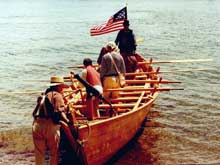
|
First Place in the Battle of Plattsburgh Challenge Cup 2005 (after fiberglass, 5 crewmen, boat stripped to lighten weight). It was a fleet of 10 boats and the competition was formidable. We won again in 2007 with a crew of three oarsmen. This is a short triangular sprint race around two marker buoys.
What we have learned from this is that the Rooster has a good hull design, plus a strong crew that has trained together for seven years.
In 2005 we were still leaking at the second strakes and taking on water through the sides. We’re not sure that the fiberglass did anything more for us than hold the bottom together. We were still hauling wet wood. However, each year we go over the caulking and each year we make it drier. We learned that simple cotton string can be used to plug fine leaks in the strakes while underway.
There is a fine correlation between the size of the boat and the length of the oars. If they are too short, the efficiency of the crew diminishes. If they are too long, the leverage power increases but the ability of the crew to pull them diminishes. In the case of the Rooster, I believe the length and balance of the 12’ oars (and 14’ steering sweep) is about just right. There also is a correlation between the surface size of the oar face and the efficiency of the crew. Somebody has probably worked out formulas for all this, we just hit it by dumb luck.
Why the name “Rooster”? During the original Battle of Plattsburgh on Sept. 11, 1814, the American flagship was the Saratoga, master commandant Lt. Thomas Macdonough. On the deck of the Saratoga were a few crates of fighting cocks, that being a favorite sailor’s sport. One of the first cannonballs fired by the British flagship, the Confiance, hit one of those crates on the Saratoga, busting it apart. The rooster was unharmed, flew up onto the gunwale, and started crowing rather defiantly. The American sailors took that as a good omen and they carried the day; so we decided to honor that brave bird.
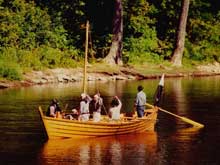 |
Drifting on the Saranac River, Plattsburgh, NY |
The Rooster is currently owned and housed by the Battle of Plattsburgh Association. Our scheduled outings for this year are at Fort La Presentation, Ogdensburg, NY, on the St.Lawrence River, July 18-20; Sackets Harbor, NY, on Lake Ontario, August 1-3; and Plattsburgh, NY, on Lake Champlain, September 12-14.
Fair winds….
Don Craig
dcraig@westelcom.com
|

